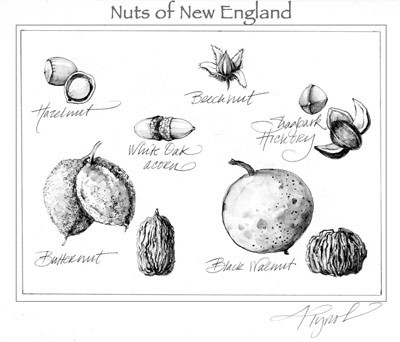
From hickory nuts and beechnuts to hazelnuts and acorns, nut-bearing trees and shrubs produced a bounty this year. Local wild nuts are free and healthy to eat. Plus, they don’t require burning carbon-emitting fuels to transport them from growers thousands of miles away. Wild nuts are organic, unless someone has sprayed chemicals on local trees and shrubs. And it’s fun to gather them with family and friends.
Some of our most useful wild nut trees, including black walnut, shagbark hickory and white oak, are mostly found in western and southern Vermont and in the southern and coastal reaches of New Hampshire. Black walnut trees prefer rich, moist woodlands; but they also grow in parks, backyards, village greens and along roadsides. Sadly, a close relative, butternut (white walnut), once grew throughout the northern woodlands, but the tree has been decimated by a canker disease.
Walnuts have been called ambrosia—food of the gods. The Latin genus, Juglans, means “Jove” or “Jupiter,” the Roman deity of the sky. In fact, black walnuts are superior sources of nutrition, being 25 percent protein and rich in Omega-3, polyunsaturated fats, which current research suggests may promote heart health, decrease the incidence of certain cancers, enhance memory function and reduce risk of arthritis.
Walnuts have a thick, spongy green husk with a sticky coat. Inside is a stubborn shell that requires a nutcracker, hammer or rock to open. I once met a black-walnut aficionado who folded the nuts into a sheet on his driveway and ran over them with his car. Nutmeats can be boiled to extract the oil, or they can be ground to make a rich-tasting additive. But don’t keep the nutmeats for more than a few weeks or they will become rancid. They can be stored for a few months if refrigerated, and longer if frozen.
Hickory nuts produce a generous yield (one pound of nutmeats from two pounds of nuts) for far less work with a nutcracker. The sweetest nuts come from shagbark hickory, so named for its large, peeling plates of bark. Each husk encloses a thick shell around a tasty nut. Eat them out of hand or substitute them for walnuts when cooking.
Oak trees commonly grow alongside hickories. Acorns from the white oak group, whose leaves have rounded lobes and tips—including white oak, swamp oak and chestnut oak—are best for eating. Trees in the black oak group—such as black oak, red oak and scarlet oak with their sharp-tipped leaves—produce acorns with too much bitter tannin.
Gather white oak acorns soon after they fall, remove the shells and drop them into a pot of boiling water for 15-20 minutes until the water turns brown. Drain and repeat, and then put the nuts in a well-ventilated place to dry. Roast the dried nuts at 300 degrees for about an hour, then eat them plain or grind them into a flour-like meal to be used in bread-baking.
Fortunately, some of our wild nut bearers, such as American beech and hazelnut, grow throughout much of New Hampshire and Vermont. Beech trees bear nuts annually, setting a heavy crop every third year. Two to three, three-quarter-inch triangular nuts nestle inside each bristle-covered husk. After removing the nuts, roast them at 350 degrees for about five minutes, then cool and eat out of hand. They also can be processed in a small cider press to obtain the oil, or dried and ground into flour.
Our local hazelnuts, which are closely related to European filberts, are steeped in folklore. Young colonial women sometimes would name hazelnuts after desirable male acquaintances. When the hazelnuts were then thrown onto the glowing coals of the hearth, the name associated with the nut that flared brightest became that woman’s “fate” in marriage. We still say someone “holds a flame” for the object of his or her affection.
One must hurry to gather hazelnuts, because squirrels and mice quickly consume or add them to their winter middens. American hazelnut grows to eight feet tall in hedgerows and moist woodlands. The ripe nuts, gathered in September, have thin shells and sweet meats. The nutmeats, fortunately, separate easily from the shell. They can be eaten raw, roasted or ground into flour, and are an excellent source of potassium.
With the holidays coming, consider wild nuts as a wholesome and delicious treat. Try using black walnut meats in turkey stuffing, in meatless casseroles or when making cakes, cookies and fudge. For a holiday cookie, find a recipe for “pecan sandies” and substitute ground hazelnuts for the pecan meal. And, since kids love to crack nuts open and eat them, drop a handful of hazelnuts into their Christmas stockings.

